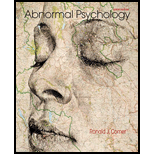
Introduction
In order to study human sexual behavior and sexual preferences, researchers tend to rely on the survey research method to gather data from the sample population. These surveys are helpful in discovering the frequency of sexual experiences, choices, and struggles people face with regards to sexual intercourse. However, the survey method of studying sexual behavior may be subjected to certain limitations and drawbacks.
Explanation of Solution
Suggested response
Some challenges are faced by survey researchers when they study people's rate of sexual behavior through survey method. For instance:
-people may not be open to talk about a sensitive and subjective topic, such as sex, to a stranger. A subject like sex, which is surrounded by taboo, is usually approached with a lot of hesitation and inhibitions.
-a person's inability to accurately recall the number of times they had sexual intercourse. Memory errors may interfere with accurate recall of past experiences.
-social desirability and a need to form an impression might cause people to lie about their frequency of sexual behavior in order to avoid feeling ashamed or embarrassed.
-since people's preferences and desires seem to change and grow with age and time, these surveys may not be reliable in studying sexual behavior. People may experience dramatic shifts in the frequency of sexual experiences for a number of different reasons over a period of time. Therefore, at times, survey study cannot yield appropriate conclusions.
Want to see more full solutions like this?
- Write an example of a personal reflection of your course. - What you liked about the course. - What you didn’t like about the course. - Suggestions for improvement. The Reflection Paper should be 1 or 2 pages in length.arrow_forwardHave you experienced a state of flow? If so, please describe what you experienced, and what factors you think contributed to this occurring. If not, discuss what you think might assist you in experiencing flow. Do you believe it is necessary to be in a state of flow to fully engage in creative work; or is it helpful but not strictly necessary? Support your position with your own observationsarrow_forwardThis unit is designed to introduce students to the principles of community psychology and examine local issues through a lens of social determinants of health. Students will explore varieties of community issues such as homelessness, substance abuse, visible and invisible disabilities, and the public health crisis of racism. By analyzing the ways in which SDH intersects with both physical and mental health, both in their own communities and in differing communities, students will understand how social inequities can significantly impact the overall health of a population. Short Description This activity explores how inequality has both physical and psychological impacts on the individual and the community's health. Students will use a step-by-step analysis of SDH around the world. Instructions Using the unit readings, review the Social Determinants of Health: Public Health Agency of Canada. (2020, October 7). Social determinants of health and health and health inequalities. Government…arrow_forward
- Match the term with its description. Prompts Answers Prime Prime form started at a different pitch level Retrograde The original row Inversion Prime formed backward Transposition Original row with all intervals invertedarrow_forwardWrite an example of a peer evaluation. Instructions: Clarity and coherence of writing Depth of musical analysis Accuracy and relevance of observations Organization and structure of the report Grammar, spelling, and punctuation Originality of workarrow_forwardMusical Interculturalism : Shakira - Waka Waka Instructions: Describe the cultural elements or influences present in the music and how they contribute to the overall sound and meaning. Discuss your personal connection or appreciation for this intercultural musical example. Reflect on how musical interculturalism enhances our understanding and appreciation of diverse cultural expressions through music.arrow_forward
- What examples of musical interculturalism come to mind for you? Example: Shakira - Waka Waka Instructions: Describe the cultural elements or influences present in the music and how they contribute to the overall sound and meaning. Discuss your personal connection or appreciation for this intercultural musical example. Reflect on how musical interculturalism enhances our understanding and appreciation of diverse cultural expressions through music.arrow_forwardI need help finding 12 peer-reviewed articles on body modification that has to do with attractiveness with people with tattoos an those without tattoosarrow_forwardMatch a jazz style with its representative musician. Prompts Answers Progressive Jazz Poncho Sanchez Third Stream Gunther Schuller Fusion Stan Kenton Latin Jazz Miles Davisarrow_forward
- Match the subgenre with the short description. Prompts Answers Progressive Jazz A style that combines elements of jazz and classical music Fusion A subgenre of Latin Jazz that incorporates elements of Brazilian samba Bossa Novia A style that combines hip hop and jazz Jazz Rap A style that, in the 1970s and 1980s, integrated elements of Jazz and Rockarrow_forward12-tone composers: (Mark all that apply) 1) Stressed dissonance and fragmentation 2) Avoided a tonal center 3) Favored extensive programmatic works 4) Created angular and disjointed melodiesarrow_forwardGershwin’s famous composition Rhapsody in Blue uses: (Mark all that apply) 1) Jazz-like rhythms 2) Extended brass sections 3) A clarinet slide 4) References to the bluesarrow_forward
 Ciccarelli: Psychology_5 (5th Edition)PsychologyISBN:9780134477961Author:Saundra K. Ciccarelli, J. Noland WhitePublisher:PEARSON
Ciccarelli: Psychology_5 (5th Edition)PsychologyISBN:9780134477961Author:Saundra K. Ciccarelli, J. Noland WhitePublisher:PEARSON Cognitive PsychologyPsychologyISBN:9781337408271Author:Goldstein, E. Bruce.Publisher:Cengage Learning,
Cognitive PsychologyPsychologyISBN:9781337408271Author:Goldstein, E. Bruce.Publisher:Cengage Learning, Introduction to Psychology: Gateways to Mind and ...PsychologyISBN:9781337565691Author:Dennis Coon, John O. Mitterer, Tanya S. MartiniPublisher:Cengage Learning
Introduction to Psychology: Gateways to Mind and ...PsychologyISBN:9781337565691Author:Dennis Coon, John O. Mitterer, Tanya S. MartiniPublisher:Cengage Learning Psychology in Your Life (Second Edition)PsychologyISBN:9780393265156Author:Sarah Grison, Michael GazzanigaPublisher:W. W. Norton & Company
Psychology in Your Life (Second Edition)PsychologyISBN:9780393265156Author:Sarah Grison, Michael GazzanigaPublisher:W. W. Norton & Company Cognitive Psychology: Connecting Mind, Research a...PsychologyISBN:9781285763880Author:E. Bruce GoldsteinPublisher:Cengage Learning
Cognitive Psychology: Connecting Mind, Research a...PsychologyISBN:9781285763880Author:E. Bruce GoldsteinPublisher:Cengage Learning Theories of Personality (MindTap Course List)PsychologyISBN:9781305652958Author:Duane P. Schultz, Sydney Ellen SchultzPublisher:Cengage Learning
Theories of Personality (MindTap Course List)PsychologyISBN:9781305652958Author:Duane P. Schultz, Sydney Ellen SchultzPublisher:Cengage Learning





